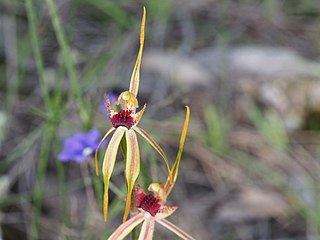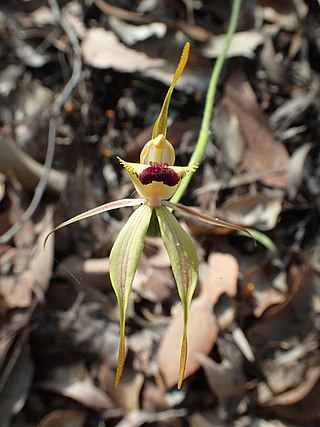
Caladenia paludosa, commonly known as the swamp spider orchid, is a species of orchid endemic to the south-west of Western Australia. It has a single erect, hairy leaf and up to three red, greenish-yellow and cream-coloured flowers. It mostly grows in dense scrub and is one of the last of the similar spider orchids to flower.

Caladenia excelsa, commonly known as the giant spider orchid, is a species of orchid endemic to a small area in the south-west of Western Australia. It is a rare species with a single, hairy leaf and up to three cream-coloured to greenish-cream flowers with long, drooping sepals and petals. It is one of the tallest spider orchids in Western Australia and, with Caladenia splendens, has the largest flowers of any Western Australian orchid.

Caladenia exstans, commonly known as the pointing spider orchid, is a species of orchid endemic to a small area in the south-west of Western Australia. It has a single, hairy leaf and one or two green, yellow and red flowers with a labellum which does not curl downwards but "points" forward.

Caladenia graniticola, commonly known as the Pingaring spider orchid, is a species of orchid endemic to the south-west of Western Australia. It has a single, hairy leaf and one or two yellowish-green, red and white flowers which have a greenish-yellow and white labellum with a red tip. It was originally described as Caladenia hoffmanii subsp. graniticola but has a slightly different labellum and column.

Caladenia granitora, commonly known as the granite spider orchid, is a species of orchid endemic to the south-west of Western Australia. It has a single, hairy leaf and one or two yellowish-cream, white and red flowers which have a white labellum with a red tip.
Caladenia hoffmanii, commonly known as Hoffman's spider orchid is a species of orchid endemic to the south-west of Western Australia. It has a single, hairy leaf and one or two, greenish-yellow, red and white flowers which have a greenish-yellow labellum with a red tip. It is distinguished from the Pingaring spider orchid by small differences in the labellum and more northerly distribution.

Caladenia horistes, commonly known as the cream spider orchid is a species of orchid endemic to the south-west of Western Australia. It has a single, hairy leaf and one or two, creamy-yellow flowers which have a red-striped labellum and long, dark, thread-like tips on the sepals and petals.
Caladenia incrassata, commonly known as the puppet clown orchid is a species of orchid endemic to the south-west of Western Australia. It has a single, hairy leaf and usually only one greenish-yellow and red flower which has a red-striped labellum.

Caladenia infundibularis, commonly known as the funnel-web spider orchid is a species of orchid endemic to the south-west of Western Australia. It has a single hairy leaf and up to three greenish-yellow flowers which have a red-tipped labellum.

Caladenia longiclavata, commonly known as the clubbed spider orchid is a species of plant in the orchid family, Orchidaceae and is endemic to the south-west of Western Australia. It is a widespread and common orchid with a single, hairy leaf and one or two greenish-yellow, white and red flowers and which grows in the area between Perth and Albany.
Caladenia luteola, commonly known as the lemon spider orchid, is a species of orchid endemic to the south-west of Western Australia. It has a single, hairy leaf and up to three lemon-yellow flowers with red stripes on the labellum. It is only known from two small populations near Woodanilling.

Caladenia macrostylis, commonly known as the leaping spider orchid, is a species of orchid endemic to the south-west of Western Australia. It has a single, hairy leaf and up to three distinctive pale greenish-yellow and red flowers with a cluster of deep purplish calli in the centre of its labellum.

Caladenia multiclavia, commonly known as the lazy spider orchid is a species of orchid, endemic to the south-west of Western Australia. It has a single, hairy leaf and one or two greenish-yellow, red and cream-coloured flowers resembling a reclining spider. Although it usually only has a single flower, it often grows in clumps of up to six plants.

Caladenia pachychila, commonly known as the dwarf zebra orchid, is a species of orchid endemic to the south-west of Western Australia. It has a single erect, hairy leaf and one or two greenish-yellow and red flowers with a red-striped labellum which has a dense cluster of deep purple calli in its centre. It is similar to the zabra orchid but has smaller flowers and the lateral sepals do not clasp the ovary.

Caladenia rhomboidiformis, commonly known as the diamond spider orchid, is a species of orchid endemic to the south-west of Western Australia. It has a single erect, hairy leaf and one or two green, yellow and red flowers. Until 1971 It was known as a variety of the green comb spider orchid Caladenia dilatata then, until 1989 as a variety of the clubbed spider orchid, Caladenia longiclavata.

Caladenia roei is a species of orchid endemic to the south-west of Western Australia. It is also known as the common clown orchid, clown orchid, ant orchid, man orchid and jack-in-the-box. It has a single erect, hairy leaf and up to three greenish-yellow and red flowers with a relatively broad labellum. It is a common orchid throughout the south-west and is especially common on granite outcrops.

Caladenia thinicola, commonly known as the Scott River spider orchid, is a species of orchid endemic to the south-west of Western Australia. It has a single erect, hairy leaf and up to four yellowish-green and red flowers with a fringe of long teeth on the sides of the labellum and thick brown, club-like glandular tips on the sepals.
Caladenia viridescens, commonly known as the Dunsborough spider orchid, is a species of orchid endemic to the south-west of Western Australia. It has a single erect, hairy leaf and up to three pale greenish-yellow flowers with faint red or pink markings.

Caladenia williamsiae, commonly known as Judy's spider orchid, or Williams' spider orchid is a species of orchid endemic to the south-west of Western Australia. It is a rare species with a single relatively large, erect, hairy leaf and one or two delicate, greenish-yellow and red flowers. It is only known from a single population near Brookton.

Caladenia xantha, commonly known as the primrose spider orchid, is a species of orchid endemic to the south-west of Western Australia. It has a single erect, hairy leaf and up to three yellow flowers with a cream-coloured, brown-striped labellum.

















